This album contains images from Todd Reed: 50 Years Seeing Michigan Through a Lens
Explore 50 years of Michigan’s beauty in this uniquely showcased photography art book by Todd Reed - first through his eyes as a highly acclaimed photojournalist, then as a distinguished Coast Guardsman, and since 1975 as one of Michigan’s best-known award-winning outdoor photographers. Travel along with Todd as he recalls stories and recollections of family and friends as he worked four careers simultaneously to eventually attain his goal as a full-time photographer and gallery owner. Discover Michigan’s four seasons as he displays his favorite scenes from across our great state and invites you to share in his memories.
Todd Reed has been photographing Michigan for 50 years and is considered by many to be one of the best landscape photographers in the United States. Todd and his team have published a large format, high-end, hard-cover coffee table book that highlights many aspects of his life and professions to commemorate that wonderful milestone.
The retrospective book is 12 inches square and has almost 400 pages. The book includes a few old family photos from when Todd was young. It also has several images from Todd’s 23 years as a photojournalist at the Ludington Daily News. Of course, the book includes many of Todd’s best-selling images of all time, along with new, longer stories behind those timeless favorites over the 50 years. In addition, Todd was very busy making new photographs in his 50th year, and the book showcases 67 of his brand new, never-before-seen images from 2020.
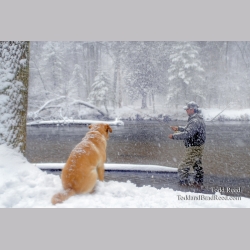
Orvis
Orvis the dog watched intently as professional fishing guide Chris “Uber” Raines defied the wintery weather to fly fish for steelhead on a flies-only stretch of the Pere Marquette River near Baldwin. The stretch of the National Wild and Scenic River known as the Claybanks looked like a winter wonderland as the biggest, stickiest snowflakes I had ever seen clung to everything in sight. “There is something almost magical about standing in the river as the water sweeps past you and the snow is coming down; it’s mesmerizing,” Raines said.
This was a perfect day for die-hard fishermen, Labrador Retrievers and photographers. It didn’t start out that way. January 17, 2012, started out with pouring rain. Brad and I had committed to a yearlong book project, photographing Michigan all day each Tuesday of the year. This was the third Tuesday, so we had to find a way to make good images despite the ugly weather. We say, “bad is good” in outdoor photography, meaning that often the best images are made in the worst weather.
I spotted and photographed misty-looking Emerson Lake near Walhalla with a giant weeping willow in the foreground making the scene appear more mystic. Ten more miles down the road Brad spotted a scene sure to brighten the gloomiest shooting day—bright red winter berries amidst cattails. The rain and mist softened the swampy background and made the winter berries rocket out of the scene far more than they would on a sunny day. Even with two good images in the bank, it looked like a very challenging day to make strong book images that would wow people. But onward we went; we were not about to give up. Michigan would surely find a way to deliver on her worst day. By mid-morning we had worked our way to the Pere Marquette Lodge Orvis fishing shop south of Baldwin, hoping to learn where we could photograph some trout fishermen. While owner Frank was obliging us by arranging for us to rendezvous with one of his guides who’d be doing some off-duty fishing, we noticed the rain was turning to snow. A half-hour later, when we started hiking a wooded trail to the river at Claybanks, the world had been transformed into a fairyland. Chris was hoping the fishing would be good. Brad and I knew at that point we were going to catch some magical photographic moments. We each did. This image wound up being my favorite shot of the entire year-long book project, during which I tripped the shutter more than 20,000 times. I sure was glad we overcame our gloomy attitudes at the start of that rainy morning and kept on keeping on. “Don’t be a quitter,” is a lesson my dad insistently taught me, and I’m glad the lesson stuck.
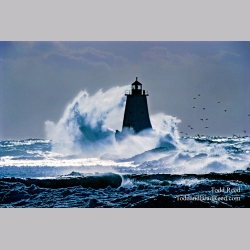
White Squall
I have photographed dozens of storms with waves as big as or bigger than those I shot during this February 1995 storm, but this image remains one of my favorite storm images because of the wave’s shape, position in relationship to the Ludington lighthouse, position of the seagulls and drama created by the storm light. I consider this image “perfectly poetic.” As my Grandma Reed liked to say about her small but precisely designed and tastefully decorated home: “There is a place for everything, and everything in its place.” I made dozens of exposures on Fuji Velvia film this day, none so perfectly poetic as this one. My youngest son, Willie, and I watched this February storm for hours, capturing photographic moments during lulls in the blizzard. As sunset neared, I prayed for storm light. If this magic light arrived, it would appear shortly before sunset, and only if the sun could find its way through, or beneath, a band of boiling clouds skirting the distant horizon. It is a photographer’s game of hide-and-seek I have played with the sun and clouds thousands of times. I love winning, but experience has taught me that I am more likely to lose or at least not win big. This time, as I had envisioned, sunlight broke from beneath the clouds, backlighting the waves and the lighthouse. Rewarded by the knowledge of what could happen and by perseverance, Willie and I were oblivious to the gale winds pummeling us as we witnessed the magic light and lake’s fury come together against the storm cloud backdrop.
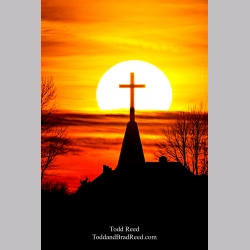
Todd Reed's Day 22 of 365
January 22, 2010”
“He is risen!” That familiar Christian declaration of faith in Jesus as savior came to mind on January 22, 2010 as I lined up the sun with the cross marking the long-recognized death site of missionary explorer Pere Jacques Marquette. According to the Jesuits, Father Marquette died on May 18, 1675, near this hilly spot between Pere Marquette Lake and Lake Michigan. I had been trying to make a sunset image like this for years, regularly scouting the potential from across Pere Marquette Lake during evening drives home. On this day the cross, sun, clouds and color combined to create a view better than I had ever imagined. One glance told me this was the day! But the sun was not quite lined up. I quickly calculated that if I could get to the end of the Ludington Yacht Club peninsula in time, everything might align. I drove the two blocks quickly, jumped out of my truck with my camera, 500-millimeter lens and tripod and ran until I ran out of land. Still the sun did not line up with the cross. Fortunately, a cold spell had built up the ice on Pere Marquette Lake. I did not hesitate to keep sprinting onto the ice. Twenty yards of running without falling on the slick ice later, everything lined up. I mounted the camera on the tripod, fine-tuned the tripod position and fired. Then I breathed a sigh of relief. Thank God for good ice.
I lived a few blocks away from this cross for more than a dozen years. During all those years of passing by the monument, almost daily, I had made only a few images of the cross that pleased me. None of them held a candle to this one. This image is especially dear to my heart not only because of its Christian symbolism but also because I have always loved and valued history, including the history of Father Marquette’s Ludington connection. Ludington was recognized as the death site of Father Marquette by generations of local Native Americans and settlers. In fact, when the area was first settled, Ludington was named Pere Marquette in honor of Father Marquette. The town was years later renamed Ludington in 1864 at the request of the most powerful lumberman in Pere Marquette at the time, James Ludington. The Pere Marquette River, Pere Marquette Lake, a street, a township and much more remain named Pere Marquette. Many different crosses have marked this spot over the centuries. This cross was erected in the 1950s as a community project. In 2019 and 2020, a new base for the cross was built through another community effort, and the cross has been put back in place to tower over Pere Marquette Lake. A lot of people believe that cross belongs there; I am one of them.
Framing Autumn
One of the concepts my son Brad and I emphasize to our photography students is framing. Using something in the foreground to frame or partially frame an image provides immediacy, depth and added interest elements. I framed this shot shortly after sunrise at the beginning of November along the Lost Lake Trail.
Harvest Drama
Contending with Mother Nature is a way of life for farmers. When I saw this farmer trying to get this Riverton Township field harvested ahead of an approaching weather front, I knew I had to try to tell the story of man against the elements with my camera. I parked my truck and ran out into the field and hit the ground to frame the harvester and farmer against the storm clouds. I looked for that moment when the farmer looked back

Todd Reed's Day 22 of 365 - Panoramic
January 22, 2010”
“He is risen!” That familiar Christian declaration of faith in Jesus as savior came to mind on January 22, 2010 as I lined up the sun with the cross marking the long-recognized death site of missionary explorer Pere Jacques Marquette. According to the Jesuits, Father Marquette died on May 18, 1675, near this hilly spot between Pere Marquette Lake and Lake Michigan. I had been trying to make a sunset image like this for years, regularly scouting the potential from across Pere Marquette Lake during evening drives home. On this day the cross, sun, clouds and color combined to create a view better than I had ever imagined. One glance told me this was the day! But the sun was not quite lined up. I quickly calculated that if I could get to the end of the Ludington Yacht Club peninsula in time, everything might align. I drove the two blocks quickly, jumped out of my truck with my camera, 500-millimeter lens and tripod and ran until I ran out of land. Still the sun did not line up with the cross. Fortunately, a cold spell had built up the ice on Pere Marquette Lake. I did not hesitate to keep sprinting onto the ice. Twenty yards of running without falling on the slick ice later, everything lined up. I mounted the camera on the tripod, fine-tuned the tripod position and fired. Then I breathed a sigh of relief. Thank God for good ice.
I lived a few blocks away from this cross for more than a dozen years. During all those years of passing by the monument, almost daily, I had made only a few images of the cross that pleased me. None of them held a candle to this one. This image is especially dear to my heart not only because of its Christian symbolism but also because I have always loved and valued history, including the history of Father Marquette’s Ludington connection. Ludington was recognized as the death site of Father Marquette by generations of local Native Americans and settlers. In fact, when the area was first settled, Ludington was named Pere Marquette in honor of Father Marquette. The town was years later renamed Ludington in 1864 at the request of the most powerful lumberman in Pere Marquette at the time, James Ludington. The Pere Marquette River, Pere Marquette Lake, a street, a township and much more remain named Pere Marquette. Many different crosses have marked this spot over the centuries. This cross was erected in the 1950s as a community project. In 2019 and 2020, a new base for the cross was built through another community effort, and the cross has been put back in place to tower over Pere Marquette Lake. A lot of people believe that cross belongs there; I am one of them.
Framing Winter
I photographed Ludington State Park for several hours on a glorious January morning after the biggest snowfall of the winter. Then it occurred to me that a spot where I had taken a photograph of fall color might also look spectacular in winter. A half-hour of hiking later, I was making this picture. The two shots show how places that are beautiful in one season may well be beautiful in another.
Charlevoix the Beautiful
Boaters love to set course for Charlevoix, especially during the annual Venetian Festival. To capture the flavor of summer in Charlevoix I set out to photograph across Round Lake toward downtown during the blue light of dusk. Fortunately the night was so still that the sailboat moored in front of me was staying almost motionless, enabling me to use a long enough shutter speed to record the movement of two of the festival amusement rides.

Storm Light
In our 20-20 Vision course, my son Brad and I teach our photography students 20 concepts we use in building strong images. We like to think of these concepts as 20 distinctly different arrows in our photography quiver that we can draw from. This is the best image I have ever made of Little Sable Point Lighthouse, not only because I used a lot of image-building arrows, but because each of them was right on target maximizing the visual impact of the photograph. The dramatic clouds in the mid-October sky enabled me to use one of my favorite arrows: “Clouds are your friends.” Not only were there great clouds, but at the moment of exposure, the clouds were wonderfully positioned in relationship to the lighthouse.
This was the fifth consecutive morning I had made the 60-mile round trip to Little Sable Point. I determined the ideal spot to place my tripod on the first day. My goal was to create a three-layer “Grand Scenic” layer cake, marrying foreground, middle-ground and background elements together in a beautiful union. A triangular mound of dune grass provided the perfect foreground and base in which to place my camera. This foreground layer was the most essential layer to make viewers of my finished photograph feel as though they were actually standing there with me. Brad and I strive to make photographs that transcend from pictures to experiences. We want viewers to step right into the scene.
I designed and built a strong image that first morning. All the compositional elements were in place. All that was needed now was God’s “magic light” to finish the image. Four mornings in a row I watched and waited. On the fifth morning the light was sharp, the westerly wind was building up some great waves into repetitive patterns, and the clouds looked especially stunning and powerful. After 100 cold minutes, a bright beam of light appeared headed my way like a giant search light. As the light hit the lighthouse, I began shooting. A few seconds later the light also lit the dune grass in front of my camera and tripod. For about five seconds in five days, one of the most glorious shoreline scenes I have ever witnessed lay before me. Then the magic light moved on, and the scene became so much less moving. I and other photographers have made subsequent photographs from almost exactly the same spot. I don’t think Mother Nature will ever duplicate this day. I thank God I realized the need to persevere and be there at this amazing moment.
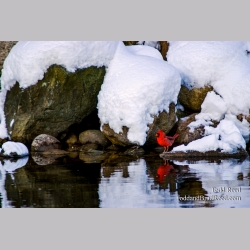
Winter Spark
I can’t imagine how many shots of songbirds I have taken in 50 years, but I can unequivocally say this is by far my favorite and most artistic. The moment this male cardinal, in all its glory, landed in this spot, I realized this was the perfect bird in the perfect position in the perfect place at the perfect time. The bright red bird rocketed out of the monochromatic background of the rocks and fresh snow.
I couldn’t have designed or painted a better background. Click. Mission accomplished, not because making that image was my objective; it wasn’t. I got out early that morning because of the gorgeous blanket of snow that had fallen overnight. I drove to Ludington State Park and hiked across the foot bridge to the far side of the Sable River and found a spot to hide myself, my tripod, my Nikon camera and 500-millimeter telephoto lens amidst some young pine in hopes of catching some shots of a mink or two coming out of an opening in the rocks as I had observed on a previous hike. Just as I had anticipated, a mink soon emerged. I was all set to capture the moment the mink’s splendid coat would be framed against the snow.
Photographers dream of what wildlife might do. As in this case, sometimes you can even visualize the finished picture on the wall. But of course it is up to the wildlife to decide for themselves where and how they present themselves and the course they will travel. We can’t pose them. For more than two hours I watched mink occasionally come out and go back in. Never did one of them set foot in the snow. I was getting more frustrated and colder by the minute. Suddenly a cardinal flew in. Fortunately, my camera was already trained and focused on the spot because cardinals almost never stay still for more than a few seconds.
Because I chose to get off the couch, because I got out early to take advantage of the fresh snow, because I had paid my dues spending a lot of time at the park, because I had previously seen the mink along the river in that location, and because I overcame the great disappointment of the lack of cooperation from the mink, because I stayed, I made a completely unexpected but better image that will be most pleasing to me for the rest of my life. Many of my favorite images did not come easy. That makes them especially rewarding.
Evening in Fish Town
Looking downstream from the Leland River dam, it is easy to imagine what this fishing village looked like a century ago. The citizens of Leland have gone to great lengths to preserve the historic look of this still active commercial fishing port.

Winter at Cherry Hill Farm
My son Brad and I teach that 90 percent of a good outdoor photograph is about the light and or atmosphere. Three videographers were with me on a late January early evening that could best be described as gray on the emotional scale. They probably wondered why I was stopping along this country road with it getting so dark. However, I instantly saw, looking at Cherry Hill Farm, that the soft snowfall was creating a painterly, Christmas-card atmosphere that I could previsualize much brighter. A longer exposure would do just that but I needed the snowflakes to remain relatively distinct. Adding to my challenge, I wanted as much of the scene sharp as possible. The solution was to raise my ISO (digital sensor sensitivity speed) to a fast 3200, which allowed me to shoot at a relatively fast shutter speed (1/100th second) and still maintain a medium depth of field (f9). All I had to do now was slap down the tripod, mount the camera and trip the shutter. I have studied and photographed our Conrad Road neighbors’ farm for years. This image is one of my wintertime favorites
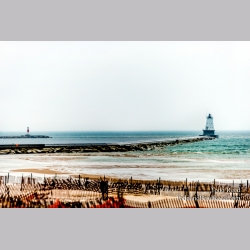
Low Meteotsunami
The Ludington North Breakwater was underwater for a short time on April 13, 2018, at the height of one of the largest meteotsunamis ever observed on Lake Michigan in the Ludington area. I photographed the flooded pier (image top left) from the Ludington beach at Stearns Park moments after a fast-moving hail and rain storm swept ashore. Only nine minutes later, I captured the much lower than normal water level (image bottom left) as the flood waters washed back into Lake Michigan. Notice the shallowness of the water and the amount of boulders visible along the edge of the pier. According to NOAA’s Great Lakes Environmental Research Laboratory (GLERL), two separate meteotsunamis occurred within a short time. GLERL said the meteotsunamis were caused by “short, extreme bursts of wind and pressure.” The Weather Channel reported that thunderstorms trigger most meteotsunamis. Small meteotsunamis are not unusual but destructive ones like this one tend to happen only once every 10 years on average, according to Eric Anderson of the research laboratory




















